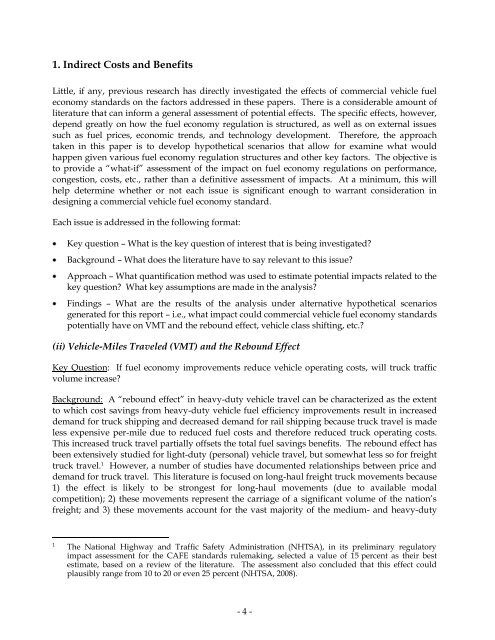Assessment of Fuel Economy Technologies for Medium and Heavy ...
Assessment of Fuel Economy Technologies for Medium and Heavy ...
Assessment of Fuel Economy Technologies for Medium and Heavy ...
Create successful ePaper yourself
Turn your PDF publications into a flip-book with our unique Google optimized e-Paper software.
1. Indirect Costs <strong>and</strong> Benefits<br />
Little, if any, previous research has directly investigated the effects <strong>of</strong> commercial vehicle fuel<br />
economy st<strong>and</strong>ards on the factors addressed in these papers. There is a considerable amount <strong>of</strong><br />
literature that can in<strong>for</strong>m a general assessment <strong>of</strong> potential effects. The specific effects, however,<br />
depend greatly on how the fuel economy regulation is structured, as well as on external issues<br />
such as fuel prices, economic trends, <strong>and</strong> technology development. There<strong>for</strong>e, the approach<br />
taken in this paper is to develop hypothetical scenarios that allow <strong>for</strong> examine what would<br />
happen given various fuel economy regulation structures <strong>and</strong> other key factors. The objective is<br />
to provide a ―what-if‖ assessment <strong>of</strong> the impact on fuel economy regulations on per<strong>for</strong>mance,<br />
congestion, costs, etc., rather than a definitive assessment <strong>of</strong> impacts. At a minimum, this will<br />
help determine whether or not each issue is significant enough to warrant consideration in<br />
designing a commercial vehicle fuel economy st<strong>and</strong>ard.<br />
Each issue is addressed in the following <strong>for</strong>mat:<br />
Key question – What is the key question <strong>of</strong> interest that is being investigated<br />
Background – What does the literature have to say relevant to this issue<br />
Approach – What quantification method was used to estimate potential impacts related to the<br />
key question What key assumptions are made in the analysis<br />
Findings – What are the results <strong>of</strong> the analysis under alternative hypothetical scenarios<br />
generated <strong>for</strong> this report – i.e., what impact could commercial vehicle fuel economy st<strong>and</strong>ards<br />
potentially have on VMT <strong>and</strong> the rebound effect, vehicle class shifting, etc.<br />
(ii) Vehicle-Miles Traveled (VMT) <strong>and</strong> the Rebound Effect<br />
Key Question: If fuel economy improvements reduce vehicle operating costs, will truck traffic<br />
volume increase<br />
Background: A ―rebound effect‖ in heavy-duty vehicle travel can be characterized as the extent<br />
to which cost savings from heavy-duty vehicle fuel efficiency improvements result in increased<br />
dem<strong>and</strong> <strong>for</strong> truck shipping <strong>and</strong> decreased dem<strong>and</strong> <strong>for</strong> rail shipping because truck travel is made<br />
less expensive per-mile due to reduced fuel costs <strong>and</strong> there<strong>for</strong>e reduced truck operating costs.<br />
This increased truck travel partially <strong>of</strong>fsets the total fuel savings benefits. The rebound effect has<br />
been extensively studied <strong>for</strong> light-duty (personal) vehicle travel, but somewhat less so <strong>for</strong> freight<br />
truck travel. 1 However, a number <strong>of</strong> studies have documented relationships between price <strong>and</strong><br />
dem<strong>and</strong> <strong>for</strong> truck travel. This literature is focused on long-haul freight truck movements because<br />
1) the effect is likely to be strongest <strong>for</strong> long-haul movements (due to available modal<br />
competition); 2) these movements represent the carriage <strong>of</strong> a significant volume <strong>of</strong> the nation‘s<br />
freight; <strong>and</strong> 3) these movements account <strong>for</strong> the vast majority <strong>of</strong> the medium- <strong>and</strong> heavy-duty<br />
1<br />
The National Highway <strong>and</strong> Traffic Safety Administration (NHTSA), in its preliminary regulatory<br />
impact assessment <strong>for</strong> the CAFE st<strong>and</strong>ards rulemaking, selected a value <strong>of</strong> 15 percent as their best<br />
estimate, based on a review <strong>of</strong> the literature. The assessment also concluded that this effect could<br />
plausibly range from 10 to 20 or even 25 percent (NHTSA, 2008).<br />
- 4 -
















